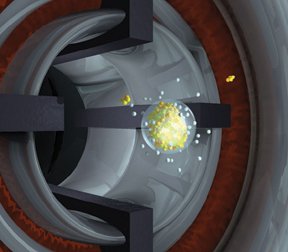Last summer, when more than 8 million trillion calcium ions blasted a thin film of americium atoms nonstop for more than a month, the collisions generated four atoms of never-before-seen element 115, a Russian-U.S. team now reports.


Each of those putative atoms of element 115 disintegrated within fractions of a second by spontaneously ejecting an alpha particle, which contains two protons and two neutrons. Therefore, the experiment appears to have also produced the first four atoms of element 113 ever recognized.
In the Feb. 1 Physical Review C, researchers of the Joint Institute for Nuclear Research (JINR) in Dubna, Russia, and Lawrence Livermore (Calif.) National Laboratory (LLNL) detail these new findings. Adding to previous results dating to late 1998, the Dubna-Livermore team has single-handedly chalked up evidence of all the elements from 113 to 118 (SN: 2/6/99, p. 85: http://www.sciencenews.org/sn_arc99/2_6_99/fob4.htm; 7/20/02, p. 37: Available to subscribers at Heavy Suspicion: Elemental discoveries trace to fake data).
“It’s very spectacular. You just have to say, ‘Wow!’,” comments nuclear chemist Walter D. Loveland of Oregon State University in Corvallis.
The new findings, which have yet to be confirmed by other laboratories, tentatively add two entries to the periodic table of the chemical elements. Because the lifetimes of these atoms—up to 1.2 seconds for element 113—are lengthy for atoms of such high masses, the findings give credence to a long-standing notion that there are many so-called superheavy elements yet to be created that could prove to be much longer-lived, says LLNL chemist Kenton J. Moody, a member of the team.
Since the 1960s, nuclear chemists have theorized that superheavy elements with lifetimes of hours, days, or even longer are possible.
Such jumbo atoms could provide a rich testing ground for currently inaccessible realms of chemistry and nuclear physics.
To create elements 113 and 115, Yuri Ts. Oganessian and his colleagues of JINR accelerated neutron-rich calcium-48 ions in a circular particle accelerator and then steered them into a spinning, saucer-size ring of americium-coated titanium foil. Calcium is element 20, and the human-made element americium is 95.
To determine what atoms were created by calcium-americium fusions and what formed from the subsequent decays of these atoms, groups of analysts at Dubna and Livermore each separately interpreted readings from detectors struck by the newly made particles.
Loveland says that such dual scrutiny has reassured other heavy-element scientists made cautious by the 1999 false claim of scientists at Lawrence Berkeley (Calif.) National Laboratory that they had discovered elements 116 and 118 (SN: 8/4/01, p. 68: Available to subscribers at Researchers take an element off the table).
Still, none of the many Dubna-Livermore findings can be considered rock-solid until other laboratories have confirmed them, Loveland cautions.







